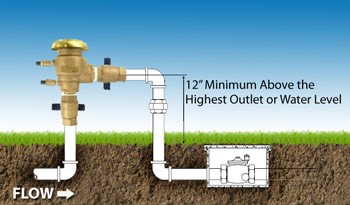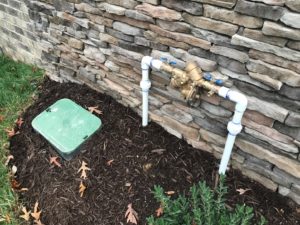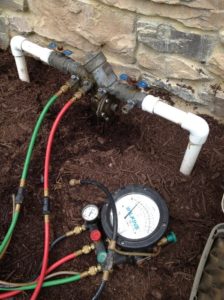What Type of Backflow Prevention Device Do I Have?
Backflow prevention devices are the most important (and most expensive) component of an irrigation system. These devices protect the drinking water by preventing possible contaminants that can commonly be found in a lawn (pesticides, pet waste, etc.) from entering your home’s water supply.
There are two types of backflow prevention devices approved for use on irrigation systems in Virginia – the PVB (pressure vacuum breaker) and the RPZ (reduced pressure zone). Both devices are effective in keeping your home’s water supply safe from possible contaminants provided they are installed properly and routinely tested (annually).
Both devices are installed above ground and are usually located near the irrigation system’s main shut-off valve, as the device needs to be upstream of all irrigation components. Because the device is located above ground and can be an eyesore, we try to install it in a location that minimizes its visibility. A great location to install a backflow prevention device is a plant bed or along the side of a home’s foundation with other equipment, such as the A/C units.
Backflow prevention devices are sized based on the pipe size of the inlet/outlet of the device, which is determined by the flow requirements of the irrigation system. Most residential properties in Richmond have either a ¾” or 1” device. The size of a device does not dramatically change its appearance until you get into the larger sizes, which wouldn’t be found on a residential property. Commercial properties will commonly have the larger devices, 1-½” and greater. There are several popular manufacturers of backflow prevention devices — Wilkins, Febco, Apollo, Watts, and more – with Wilkins overwhelmingly being the most popular in the Richmond market. When installing an RPZ backflow prevention device, Richmond Irrigation’s first choice is the Wilkins 975XL. Our choice for a PVB backflow prevention device is the Wilkins 720A pressure vacuum breaker assembly. These devices will provide years of dependable service provided they are properly winterized prior to being exposed to freezing temperatures. For more information about the difference between the two types of backflow prevention devices, please see below:
What is a PVB? (Pressure Vacuum Breaker, or PVB)
The PVB backflow prevention device only provides protection against back-siphonage, not backpressure. Therefore, it must be installed at an elevation 12” higher than the highest outlet. The outlets of an irrigation system would be the sprinkler heads. For example, if your property has significant elevation changes, you will need the PVB to be located on the highest elevation of your property – otherwise it is likely that sprinkler heads would be installed at a higher elevation. This device has two ball valves (typically with blue handles) installed in a ‘L pattern.’ The PVB has two test ports. The test ports are a small ball valve operated by a flat head screwdriver. The purpose of the ports is to allow a testing instrument to be connected to the device for its annual test. The PVB will have a name plate that contains a serial number used to complete the backflow test report form.
What is an RPZ? (Reduced Pressure Zone, or RPZ)
The RPZ backflow prevention device provides protection against both back pressure and back-siphonage. This allows it to be installed at any location/elevation of a property – which also makes it a much more expensive option. Most properties in Richmond have enough elevation change to mandate the use of the RPZ backflow prevention device. This device has two ball valves (typically with blue handles) installed ‘in line’. The RPZ backflow prevention device has four test ports – used to connect the testing equipment to the device for its annual test. The RPZ device will also have a name plate that contains a serial number that is used to complete the backflow test report form.
Do I Have a PVB or RPZ Backflow Prevention Device?
In summary, both devices perform the same task of protecting the water supply from possible contaminants. For the PVB to perform this task it must be installed higher than the highest sprinkler whereas an RPZ can accomplish this task regardless of the elevation it is located. Both the RPZ and the PVB are required to be tested annually to verify the internal components are functioning as designed. Both devices are installed on above ground piping (typically pvc) and the device itself is constructed from brass. The best way to distinguish between the two devices is to count the number of test ports. A PVB backflow prevention device has two test ports whereas an RPZ backflow prevention device has four. The picture shown to the left depicts a testing instrument connected to two of the four test ports of an RPZ backflow prevention device. Both devices will have two ball valves, one on the inlet side and one on the outlet side – however the orientation of the valves is different between the two devices. The orientation of the PVB’s ball valves are in a ‘L pattern’ whereas a RPZ’s ball valves are installed ‘in-line’.
Lastly, while it is useful to understand what type of backflow prevention device you have and its role in protecting the water supply – your best bet is to use a trusted professional when working on this device.



